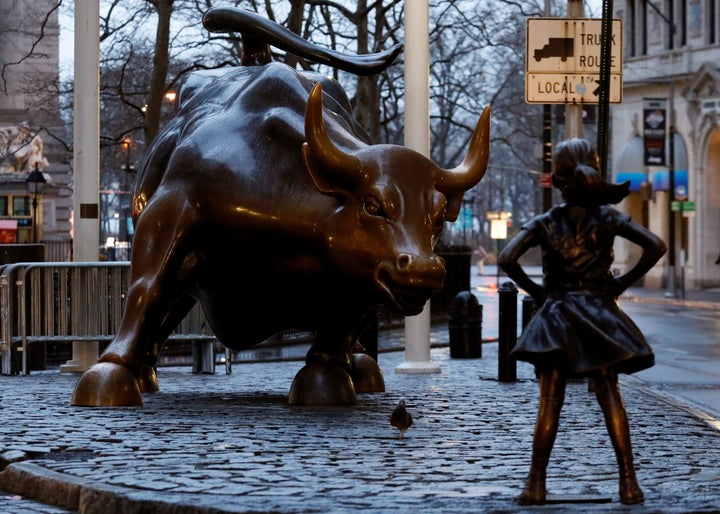Little Girl Statue Stands Up to Iconic Wall Street Bull (and Masculinity)
Charging Bull, which is sometimes referred to as the Wall Street Bull or the Bowling Green Bull, is a bronze sculpture that stands in Bowling Green Park in the Financial District in Manhattan, New York City. Originally guerilla art, by Arturo Di Modica, its popularity led to it being a permanent feature.
Description
The 7,100-pound (3,200 kg) sculpture stands 11 feet (3.4 m) tall[1] and measures 16 feet (4.9 m) long. The oversize sculpture depicts a bull, the symbol of aggressive financial optimism and prosperity, leaning back on its haunches and with its head lowered as if ready to charge. The sculpture is both a popular tourist destination which draws thousands of people a day, as well as "one of the most iconic images of New York" and a "Wall Street icon" symbolizing Wall Street and the Financial District.A poster showing a ballerina on the Charging Bull to promote the Occupy Wall Street movement
In Outdoor Monuments of Manhattan: A Historical Guide, Dianne Durante describes the sculpture:
The Bull's head is lowered, its nostrils flare, and its wickedly long, sharp horns are ready to gore; it's an angry, dangerous beast. The muscular body twists to one side, and the tail is curved like a lash: the Bull is also energetic and in motion.
The bronze color and hard, metallic texture of the sculpture's surface emphasises the brute force of the creature. The work was designed and placed so that viewers could walk around it, which also suggests the creature's own movement is unrestricted — a point reinforced by the twisting posture of the bull's body, according to Durante.
Charging Bull, then, shows an aggressive or even belligerent force on the move, but unpredictably.t's not far-fetched to say the theme is the energy, strength, and unpredictability of the stock market."
Di Modica told the New York Daily News in 1998:
That bull is one of an edition of five. … I'm hoping the other four will be going to cities all over the world, whenever somebody buys them.
In 2010, a similar Charging Bull sculpted by Di Modica, which looks "younger" and "stronger," was installed in Shanghai, called Bund Bull. In 2012 one was placed on Het Beursplein in Amsterdam.
As many American women prepare to draw attention to their role in the workplace, a Wall Street firm on Tuesday put up a statue of a girl in front of Lower Manhattan's well-known bronze charging bull, as if to fearlessly stare it down.
Placing the diminutive, grade school-aged girl in front of the massive bull on the eve of International Women's Day was a way of calling attention to the lack of gender diversity on corporate boards and the pay gap of women working in financial services, a spokeswoman for State Street Global Advisors said.
"A lot of people talk about gender diversity, but we really felt we had to take it to a broader level," said Anne McNally, whose firm is an investment management subsidiary of State Street Corp.
In conjunction with International Women's Day on Wednesday, many American women are planning to stay home from work, which has led some schools to cancel classes.
Organizers asked women who cannot afford to miss a day of work to limit their shopping to female-owned businesses or to wear red.
Although women have made some headway against the glass ceiling, State Street said one out of four of the companies that make up the Russell 3000 Index still have no female representation on their boards.
"Today, we are calling on companies to take concrete steps to increase gender diversity on their boards, and have issued clear guidance to help them begin to take action," State Street Global Advisors CEO Ron O'Hanley said in a statement.
Much the same as the charging bull, the little bronze girl by artist Kristen Visbal was put up in the wee hours of the morning as "guerilla art," McNally said. But, unlike the bull, the firm discussed it with the city beforehand so that it could remain at least temporarily.
"We're actively pursuing that it stays for a month," she said. "If the city decides that it should stay in perpetuity, we're absolutely on board with that."
The bull, sculpted by Italian-born artist Arturo Di Modica, was initially taken down after he quietly placed it in front of the New York Stock Exchange in December 1989. But it was later given a permanent home, about a five-minute walk away on Broadway, in response to public support.
Source:www.nbcnews.com
/https%3A%2F%2Fblueprint-api-production.s3.amazonaws.com%2Fuploads%2Fcard%2Fimage%2F406486%2F28e12a85-582b-4642-a06b-e4159d8a76d6.jpg)

No comments:
Post a Comment